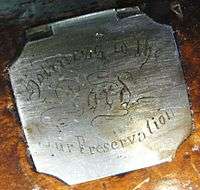Jonathan Browning (inventor)
| Jonathan Browning | |
|---|---|
|
| |
| Personal details | |
| Born |
October 22, 1805 Sumner County, Tennessee, United States |
| Died | June 21, 1879 (aged 73) Ogden, Weber County, Utah |
| Resting place |
Ogden City Cemetery 41°13′59″N 111°57′43″W / 41.233°N 111.962°W |
| Home town | Ogden, Utah, United States |
| Known For | Harmonica gun |
| Occupation | Blacksmith and Gunsmith |
| Spouse(s) | Elizabeth Stalcup m. 1826, Elizabeth C. Clark m. 1854, Sarah Ann Emmett m. 1858 |
| Children |
24 including: John M Browning |
| Parents |
Edmund Browning Sarah B. Allen |
| Relatives | Including: Val A. Browning (grandson) |
Jonathan Browning (October 22, 1805 – June 21, 1879) was an American inventor and gunmaker.
Early life
Born in Sumner County, Tennessee, he started earning a living as a blacksmith and later switched to become a lock and gunsmith. He invented a "sliding breech" repeating rifle also called a Harmonica gun between 1834 and 1842 while living in Quincy, Illinois. He achieved success with the Harmonica gun, and he received many orders. It is estimated that each Harmonica gun took 2 weeks to make, and Browning sold the guns for twenty-four dollars.
With his local prominence in Quincy, Browning was elected the justice of the peace. He came to know a young lawyer by the name of Abraham Lincoln who was an overnight guest in his home on at least two occasions.
Missouri period
In October 1838, Governor Lilburn Boggs issued the Extermination Order that caused the followers of Joseph Smith to flee Missouri. In his capacity as a judge, Browning came into contact with many of the Latter-day Saint exiles. Curious about the new settlement in the swampy lands of Nauvoo, Illinois, Browning paid a visit to Nauvoo. His meeting with church president Joseph Smith led Browning to convert to the Church of Jesus Christ of Latter Day Saints..[1][2] His conversion led to him being ostracized by the community in Quincy. Browning sold his gun shop and land in Quincy.
Nauvoo period

Browning moved to Nauvoo, Illinois and joined the LDS community in 1840, where, in 1843, he briefly established a gun shop. A year later, LDS leader Joseph Smith was assassinated, and Browning was among the group which later fled Nauvoo.
Guns that Browning produced as a Mormon gunsmith were labeled "Holiness to the Lord - Our Preservation." The Jonathan Browning Home and Gunshop built in 1842 was restored during the 1960s. Registered with The Mormon Historic Sites Foundation, the museum is open to the public at no charge.[3]
Utah period
Browning fled Illinois with Brigham Young in late 1846 to escape religious persecution. He settled in the temporary community of Council Bluffs, Iowa (then called Kanesville in honor of Thomas L. Kane) and repaired guns for the local settlers who were migrating to Utah. He was awaiting Brigham Young to invite him to join the main body of settlers in Utah. When the Mormon Battalion was formed during the War with Mexico, Browning wanted to join them, but was told by Young that his skills would not be needed by the soldiers as much as they would by the main body of pioneers in Kanesville.
As was common in the community at that time, Jonathan Browning was a polygamist, having taken three wives. He fathered 24 children; prominent among them was the gun designer, John Moses Browning, one of the most important figures in the development of modern automatic and semi-automatic firearms.
Browning received the word from Brigham Young to join the main party of settlers in 1852. He left his gunshop in Iowa July 8, 1852 and migrated across the Rocky Mountains as the captain of the Henry W. Miller Company. He arrived October 2, 1852, with six wagons and six hundred dollars in the Salt Lake Valley. Browning moved to Ogden, Utah and established a gun shop there. His activities were limited to repairs in the Ogden shop, however. His son John Moses recalled, "We ridiculed some of the guns we fixed, and I damned some of them when Pappy wasn't near, but it never occurred to us to make better ones. He was too old, and I was too young." Browning died June 21, 1879 in Ogden.
References
- ↑ Manuscript History of the Church, LDS Church Archives, book A-1, p. 37; reproduced in Dean C. Jessee (comp.) (1989). The Papers of Joseph Smith: Autobiographical and Historical Writings (Salt Lake City, Utah: Deseret Book) 1:302–03.
- ↑ H. Michael Marquardt and Wesley P. Walters (1994). Inventing Mormonism: Tradition and the Historical Record (Salt Lake City, Utah: Signature Books) p. 160.
- ↑ Mormon Historical Sites "Jonathan Browning Home and Gunshop, Nauvoo, Illinois", Retrieved July 26, 2018.
- John Browning & Curt Gentry. John M. Browning, American Gunmaker. New York: Doubleday, 1964.